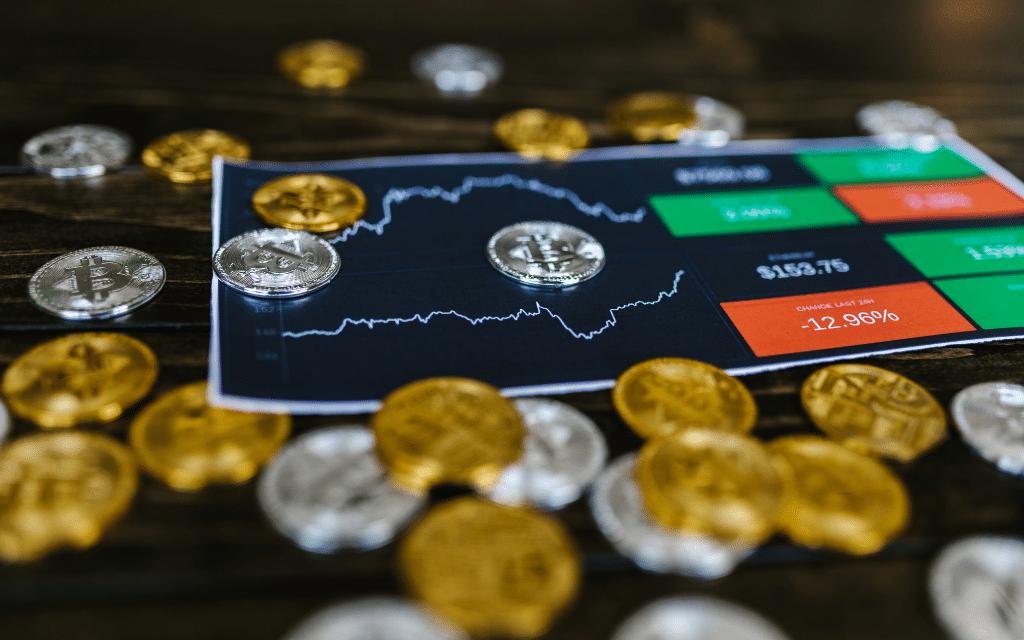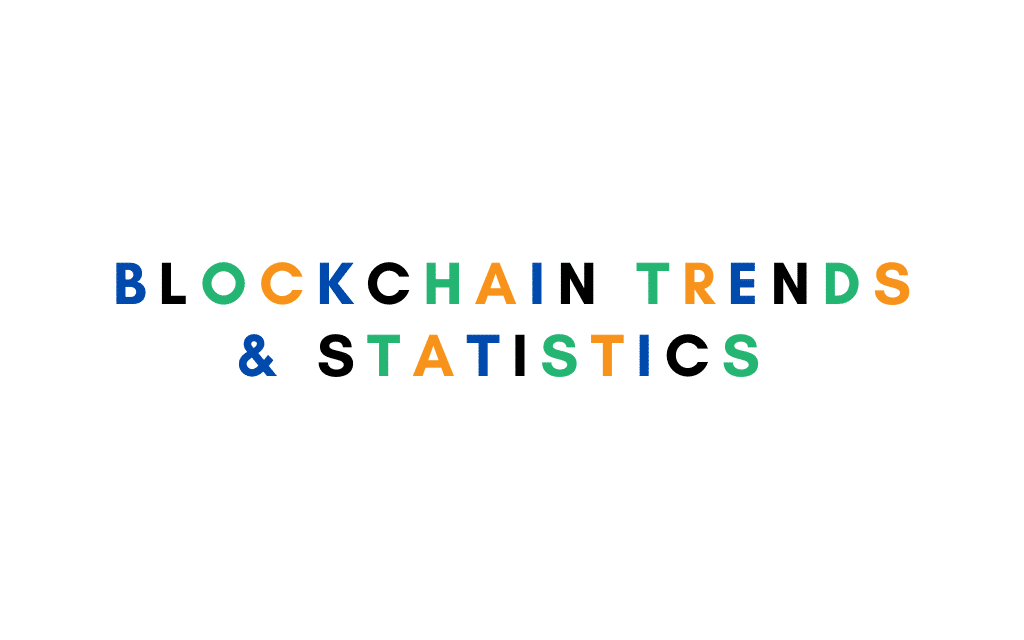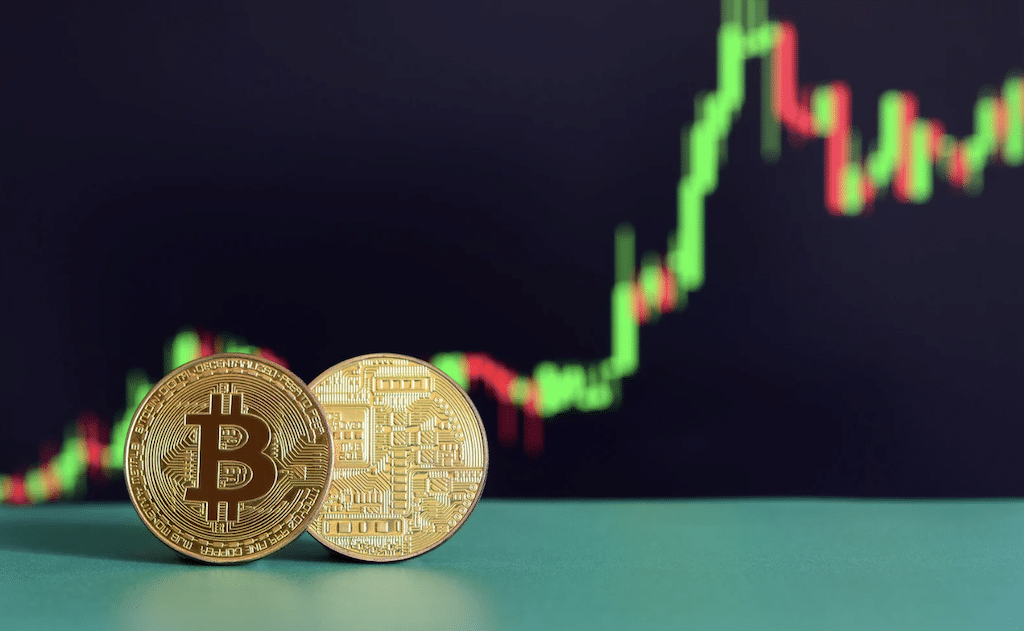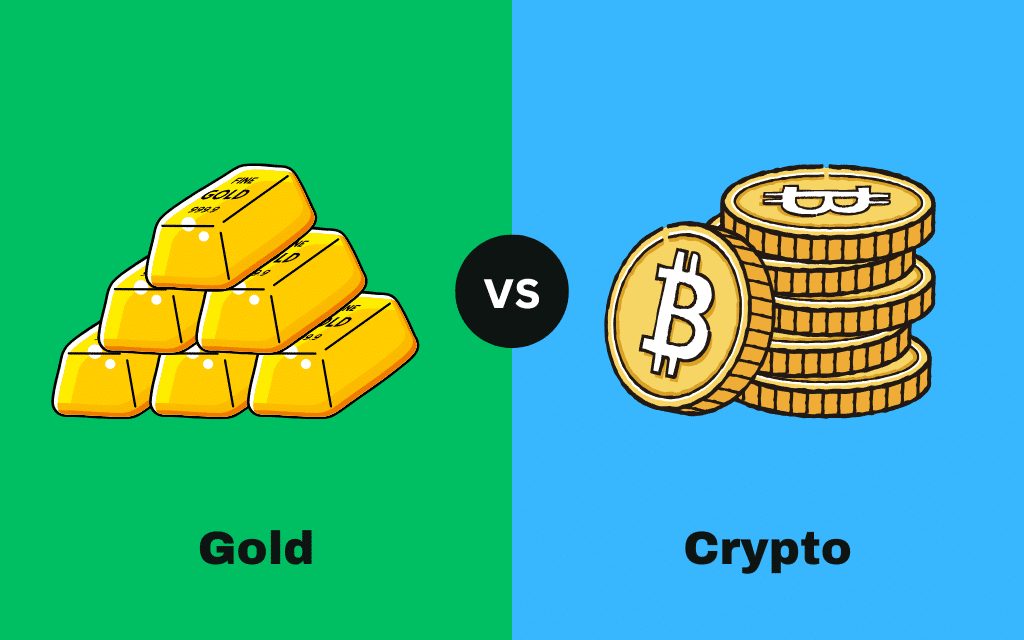Learning how to invest in gold and silver is an exciting way to diversify your investment strategy with a longstanding inflation hedge.
There are several ways to get direct or indirect exposure to gold, which has been a trustworthy currency for thousands of years, including some I invest in with small amounts of money myself.
Here are the 5 best ways to invest in gold & silver:
- Precious metals IRA
- Physical gold and silver
- Gold mining stocks
- ETFs and mutual funds
- Futures and options
How to invest in gold and silver for the first time
If you’re new to investing, one of the easiest ways to start is with stocks or funds that track gold prices.
These let you benefit from gold’s price changes without owning or storing physical gold.
Many first-time investors like these options because they have low minimum investments and are widely available through online brokers.
Gold is often seen as a safe haven during economic uncertainty or market swings. That’s why many people turn to it when stocks are volatile.
You can also buy physical gold or silver in the form of bullion, bars, or coins.
The benefit? You own the asset outright and avoid credit risk. The trade-off is that you’ll need to pay for secure storage and insurance.
No matter which option you choose, always buy from a trusted dealer to avoid scams and overpaying. Look for clear pricing, authenticity guarantees, and a strong reputation.
Each type of investment—digital or physical—has different costs, risks, and potential returns.
For example:
- Physical gold may require storage and insurance fees.
- Gold ETFs or funds may have annual management fees.
Before you invest, compare both options to see which fits your budget, risk tolerance, and retirement goals.
Adding gold or silver to your portfolio can be a smart way to diversify and help protect your savings from market ups and downs.
5 Best Ways to Invest in Gold & Silver
Gold investments are available in several forms, although the methods of investment, potential investment performance, and ease of selling assets differ.
These various methods allow investors to participate in the gold market in different ways, depending on their goals and preferences.
1. Precious Metals IRA
A gold IRA lets you own physical gold or silver coins and bars, while still getting the tax benefits of a traditional IRA or Roth IRA.
The IRS requires these metals to be stored in a third-party depository, not at home. This secure storage helps protect your investment and ensures you follow all tax rules.
Adding gold or other precious metals to your retirement portfolio can help diversify your savings and protect them from market ups and downs.
How It Works
You’ll open a self-directed IRA with help from a gold IRA company.
An IRA specialist will guide you through the paperwork—most of it is done for you.
- Usually, you’ll roll over funds from an existing IRA or 401(k).
- Most 401(k) plans don’t let you buy gold directly, but a self-directed IRA can hold physical gold and other alternative assets.
You can invest in gold, silver, platinum, and palladium from trusted mints. Self-directed IRAs can also hold gold mutual funds, mining stocks, or other gold-related investments.
Next, you’ll choose:
- An IRA custodian – manages your account and paperwork.
- A secure depository – stores your metals with full insurance.
Top Gold IRA Companies
Some of the best gold IRA companies include:
- Augusta Precious Metals – Lifetime account support and education. $50,000 minimum investment; about $200/year in fees.
- Goldco – $0 minimum investment; $175–$225/year in fees; buyback guarantee for selling at top prices.
- Noble Gold Investments – $2,500 minimum investment; gold, silver, platinum, palladium options; storage in Delaware or Texas; $225/year in fees.
These companies are known for excellent customer service, competitive fees, and a wide range of investment options.
Key considerations
Since this is a long-term retirement account, make sure you can invest enough to offset annual storage and custodial fees.
For help deciding how gold fits into your retirement plan, talk with a financial advisor.
2. Physical Gold & Silver
Buying gold or silver coins, bars, or even jewelry outside of an IRA gives you the most flexibility.
You can start small with budget-friendly amounts, and you’re not limited to IRA-approved products.
That means you can buy lower-purity items or non-currency rounds if you choose.
Key considerations
Owning physical gold comes with responsibilities:
- Safe storage to protect against theft or loss.
- Insurance costs to keep your investment protected.
Bullion coins (like American Eagles) are popular because they are legal tender and usually have lower premiums than collectible coins.
Lower premiums mean you can reach your break-even point faster.
If you want to stretch your budget, consider rounds and bars from private mints—these are often the most affordable if you care more about melt value than collectibility.
Popular physical gold & silver choices
Some of the best options can be:
- Saint Gaudens Gold Coins (Pre-1933)
- Canadian Maple Leaf
- 90% U.S. Silver Quarters and Dimes (Pre-1965)
- Gold Bars
- Silver Bars
The purity and weight of your metals are the biggest factors in resale value, though collectible value and industrial demand can also play a role.
Where to Buy
Here are some trusted dealers:
- APMEX – Free loyalty program with flash sales and early deals.
- JM Bullion – Weekly specials and discounted pricing.
- SD Bullion – Price match guarantee and strong buyback offers.
Always research your dealer, ask about fees, and understand the delivery and security process before buying.
Investing in jewelry
High-end gold or silver jewelry can also be an investment, especially if you already have a collection.
But keep in mind:
- Retail markups can be high compared to melt value.
- Jewelry is harder to appraise and sell than coins or bars.
- Collectible value can change quickly.
Owning physical gold or silver can provide stability and protection for your wealth—especially in uncertain times.
Just make sure to plan for safe storage, insurance, and buying from reputable sources.
Advantages over gold IRAs
When you buy metals directly (not in an IRA), you:
- Can store them at home.
- Avoid custodian fees.
- Skip early withdrawal penalties.
That means more money stays in your investment.
3. Gold Mining Stocks
Gold mining stocks let you invest in companies that produce gold, giving you indirect exposure to precious metals.
Unlike owning physical gold, you’re investing in a business, which can mean more growth potential—but also more risks.
Some gold mining stocks also pay dividends, which is rare in the precious metals world.
However, keep in mind that gold prices and mining stock prices don’t always move together.
Mining shares can fall if companies face problems like poor drilling results, government restrictions, lawsuits, or political instability.
Types of gold mining stocks
Gold streaming companies
- Invest in multiple mining projects and earn royalties.
- Often pay dividends.
- Lower risk for beginners and helps diversify your portfolio.
Senior miners
- Large, established companies with strong finances.
- Less risky than smaller miners.
- Stock performance often follows the price of gold, but production levels matter too.
Junior miners
- Small companies with higher risk but bigger growth potential.
- Very volatile—can see large gains or losses depending on market conditions.
Physical gold vs. mining stocks
- Mining stocks can offer bigger gains but depend on successful mining operations.
- Physical gold (or gold ETFs) usually moves directly with gold’s spot price and doesn’t rely on business performance.
- Many investors, including me, hold both for balance.
Also, some mining companies earn money from other metals, like silver and copper, which can add stability.
For example, Barrick Gold produces gold, silver, and copper.
Gold mining stocks can diversify your retirement portfolio and provide extra income through dividends. But they come with higher risk than owning physical gold.
Consider your goals, risk tolerance, and timeline before investing.
4. ETFs & Mutual Funds
Exchange-traded funds (ETFs) and mutual funds that focus on gold and other precious metals can be an easy, low-maintenance way to invest.
They give you instant diversification, since each fund may hold many gold-related assets instead of just one company.
With these funds, you don’t own physical gold. Instead, you gain exposure to gold prices through shares in mining companies, bullion holdings, or both.
This makes them more accessible and often more convenient than buying and storing coins or bars yourself.
Some funds simply track gold’s spot price, while others own shares of large and small mining companies.
A few, such as the Sprott Physical Gold Trust (PHYS), even allow you to redeem your shares for actual gold, although the process can be slow and costly.
Popular precious metals ETFs
Some of the most-traded gold ETFs include:
- iShares Gold Trust (IAU) – Tracks the price of gold.
- iShares Silver Trust (SLV) – Tracks the price of silver.
- SPDR® Gold Shares (GLD) – One of the largest and most traded gold ETFs.
- Sprott Physical Gold Trust (PHYS) – Holds physical gold and offers redemption.
- Sprott Physical Silver Trust (PSLV) – Holds physical silver.
- VanEck Gold Miners ETF (GDX) – Invests in large gold mining companies.
- VanEck Junior Gold Miners ETF (GDXJ) – Focuses on smaller, higher-risk mining companies.
These funds are passively managed and follow a benchmark, such as gold’s spot price or the NYSE Arca Gold Miners Index.
Costs and liquidity
Gold ETFs are highly liquid, meaning you can buy and sell them quickly—ideal for both short-term trades and long-term holdings.
Expect to pay an annual expense ratio of about 0.25% to 0.60%, which covers management and operational costs.
Most investing apps offer commission-free trading, helping you keep fees low.
Key takeway: If you want a hassle-free way to add gold to your retirement portfolio without worrying about storage or insurance, ETFs and mutual funds can be a smart choice. They offer diversification, easy trading, and relatively low ongoing costs.
5. Gold Futures & Options
Gold futures and options are advanced investing tools best suited for experienced investors. They can involve more risk and often require a margin account.
Gold futures are agreements to buy or sell gold at a set price on a specific date in the future.
With options, you can buy “calls” if you think gold prices will go up, or “puts” if you believe they will go down before the contract expires.
These strategies are typically short-term trades. They can be used to protect your portfolio from losses, but they also carry the risk of losing your entire investment if the market doesn’t move in your favor.
Futures offer liquidity and leverage, meaning you can control a larger position with less money—but that also increases potential losses.
Most gold futures are cash-settled, so you won’t actually take physical delivery of gold. If your contract requires delivery, you’ll need to close it before the expiration date to avoid storing the metal yourself.
Bottom line: Gold futures and options can offer big opportunities, but they’re high-risk and not typically recommended for beginners or conservative retirement investors.
Why you should invest in gold and silver?
Learning how to invest in gold yields several valuable benefits:
- Portfolio diversification
- Hedge against inflation
- Millennia store of value
- Physical or digital ownership
- Potential IRA tax benefits
- Low minimum investments
- Selects stocks and funds pay dividends
Adding gold to your investment mix can provide a financial safety net during periods of economic uncertainty and stock market volatility.
Gold continues to play a vital role in diversifying portfolios alongside other assets, especially when the stock market is unstable.
Expert’s Take
Including gold and silver in your portfolio can provide diversification, but it shouldn’t be viewed as a primary growth driver for most retirement plans.
Instead, they can act as a potential store of value during times of economic uncertainty. Whether gold or silver is appropriate for you depends on your specific situation, risk tolerance, and long-term financial goals.
It’s essential to consult with a fiduciary professional who understands how these assets may fit into a well-balanced retirement plan, taking into account market timing and your unique financial landscape.
Why you shouldn’t invest in gold and silver?
Gold and silver investing disadvantages include:
- Potentially pricey premiums for physical ownership
- Usually requires a multi-year investment period
- Annual gold IRA custodian and storage fees apply
- Collectibles tax treatment is stricter than long-term capital gains
- Multiple gold price factors influence its spot price
- It isn’t risk-free
Gold has no credit risk, unlike stocks or bonds, making it a unique asset. However, gold related financial investments, such as ETFs and mutual funds, often come with management fees that can reduce overall returns.
For physical gold, insurance costs are another ongoing expense to consider when evaluating total investment performance.
Getting Started with Investing in Gold & Silver
With so many ways to invest in gold, it’s easy to feel overwhelmed.
If you’re just starting out, consider three main options:
- Physical bullion (coins and bars)
- Gold IRAs for retirement savings
- Digital gold investments like stocks and ETFs
Buying precious metals from a reputable dealer gives you direct ownership and control. But keep in mind—you’ll need to handle secure storage and insurance yourself.
Many new investors begin with small purchases of coins, bars, or gold dividend stocks.
Over time, you can slowly grow your holdings with a long-term plan, which can help maximize growth potential and reduce taxes from frequent selling.
Adding gold to your portfolio can help diversify your retirement savings and protect against market swings.
Just remember to:
- Watch your asset mix so gold isn’t too large or too small a portion of your portfolio
- Keep an eye on premiums so you don’t overpay and can reach your break-even point faster
For the best results, talk with a financial advisor. They can help you choose the right gold investments for your goals, budget, and retirement timeline.
FAQs
Is gold and silver a good investment?
Gold and silver tend to be an excellent long-term investment when you can hold for at least five to 10 years as prices are cyclical.
Common coins and bars usually have the lowest premiums and competitive resale value. Additionally, precious metals are not a get-rich-quick investment.
Should I invest in gold and silver for retirement?
Gold and silver can serve as an effective inflation hedge and store of value against a depreciating currency.
You should have a multi-year holding period. Typically, gold is less volatile than silver and the gold-to-silver ratio can suggest the better metal to buy now.
Is it safe to invest in gold right now?
No investment is ever risk-free, although gold remains one of the best long-term investment ideas.
Gold has many positive pricing factors, including generationally high inflation rates and reduced fiat currency purchasing power, which dampen dollar-based asset values.







